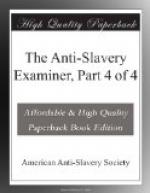[Footnote 5: For April, 1836. The General Assembly of the Presbyterian Church met in the following May, at Pittsburgh, where, in pamphlet form, this article was distributed. The following appeared upon the title page:
Pittsburgh:
1836.
For gratuitous distribution.
]
About a year after this, an effort in the same direction was jointly made by Dr. Fisk and Professor Stuart. In a letter to a Methodist clergyman, Mr. Merrit, published in Zion’s Herald, Dr. Fisk gives utterance to such things as the following:—
“But that you and the public may see and feel, that you have the ablest and those who are among the honestest men of this age, arrayed against you, be pleased to notice the following letter from Prof. Stuart. I wrote to him, knowing as I did his integrity of purpose, his unflinching regard for truth, as well as his deserved reputation as a scholar and biblical critic, proposing the following questions:—”
1. Does the New Testament directly or indirectly teach, that slavery existed in the primitive church?
2. In 1 Tim. vi. 2, And they that have believing masters, &c., what is the relation expressed or implied between “they” (servants) and “believing masters?” And what are your reasons for the construction of the passage?
3. What was the character of ancient and eastern slavery?— Especially what (legal) power did this relation give the master over the slave?
PROFESSOR STUART’S REPLY.
Andover, 10th Apr., 1837
Rev. And dear sir,—Yours is before me. A sickness of three month’s standing (typhus fever) in which I have just escaped death, and which still confines me to my house, renders it impossible for me to answer your letter at large.
1. The precepts of the New Testament respecting the demeanor of slaves and of their masters, beyond all question, recognize the existence of slavery. The masters are in part “believing masters,” so that a precept to them, how they are to behave as masters, recognizes that the relation may still exist, salva fide et salva ecclesia, ("without violating the Christian faith or the church.”)




